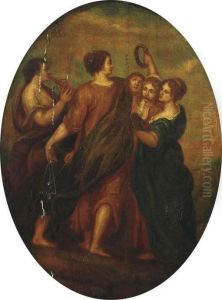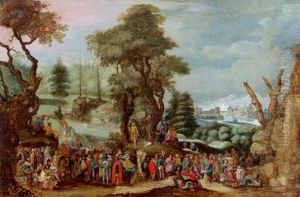Hans Ii Jordaens Paintings
Hans II Jordaens was a Flemish artist born in 1595 in Antwerp, a city that was, at the time, a significant center for art and commerce in the Spanish Netherlands. His life and career were deeply intertwined with the rich artistic tradition of the Low Countries during the 17th century, an era that witnessed the flourishing of Baroque art. Not to be confused with the more famous Jacob Jordaens, a contemporary who also worked in Antwerp, Hans II Jordaens carved out his own niche in the art world of his time.
Jordaens' early life was steeped in the artistic milieu of Antwerp. Although detailed records of his training are scarce, it is believed that he was apprenticed to a local master, which was the customary path for artists at the time. His work shows a strong influence of the Flemish Baroque style, characterized by vivid realism, dynamic compositions, and a rich, vibrant use of color. These were hallmarks of the period and indicative of the influence of other Flemish masters such as Peter Paul Rubens and Anthony van Dyck, though Jordaens developed his own distinctive approach to subjects and composition.
Throughout his career, Hans II Jordaens demonstrated versatility across religious, mythological, and genre scenes, showing a particular interest in the portrayal of everyday life. His paintings often depicted lively scenes filled with figures, showcasing his skill in composition and his ability to capture the textures and nuances of various materials. Despite his talent, Jordaens did not achieve the same level of fame as some of his contemporaries. His works were, however, appreciated by a discerning clientele for their vitality and attention to detail.
Jordaens' contributions to art extend beyond his paintings. He was part of the vibrant artistic community in Antwerp, and his works were influential in the continued development of Flemish Baroque painting. His legacy is also preserved in the collections of various European museums, where his paintings continue to be studied and admired for their craftsmanship and insight into the era's cultural and social mores.
Hans II Jordaens passed away in 1643 in Antwerp. His death marked the end of a career that, while perhaps not as celebrated as some of his contemporaries, contributed significantly to the tapestry of Flemish art. Today, he is remembered as a talented practitioner of the Baroque style, whose works offer a window into the vibrant artistic landscape of 17th-century Flanders.

